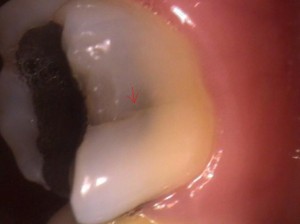Do I need treatment for these lines in my teeth?

Is this a cracked tooth or a crazeline?
As I have mentioned almost all teeth have small visible cracks in them…. I refer to these as craze lines to differentiate them from true cracks because they do not affect the structural integrity of the tooth. They are simply small micro cracks that do not extend deeply into the tooth. They may be the precursors to structural fracture lines but they seldom if ever require treatment. If you we were to treat every craze line you would be treating every tooth. The exception might be when some of these micro craze lines coalese they can pick up stain and appear dark and for esthetic reasons we may bond over the craze line to cover the discoloration.
Why do they appear?
The external surface of the teeth, the enamel, is 99% mineralized making it like a crystal. Imagine almost any crystal subjected to multiple impacts of 50,000lbs per square inch force and then thermal cycled hot and cold. I am amazed that teeth survive at all considering all we put them through chewing, grinding, and using them as tools to hold cut and bend objects. That does not even take into account the parafunctional habits like grinding and bruxing at night when we take out the days frustrations on our teeth with even higher pressures of force. Add to that our diet that contains sugar and high acids which further weaken the teeth with tooth decay.
Do fillings weaken my teeth?

Tooth with crazelines and filling
Many believe that fillings, especially silver fillings weaken the teeth. I am not sure. I have seen teeth fracture away from fillings of all kinds: silver, gold and even bonded porcelin fillings. The skulls of ancient man contain numerous fractured teeth and no fillings. I do think that when the circular structure of the tooth is weakened by decay or any filling material and almost any filling material used to replace tooth structure causes a decrease in the strength of the tooth … a “c” is not as strong as a circle. That is why the newer treatment philosophies in dentistry emphasis conservation of tooth structure and remineralization not “drill, fill and bill”( More later about the newer technologies and philosohies of treatment.) Some claim that the newer porcelin bonded fillings strengthen the teeth so why not just drill and fill if the craze line may become a crack in the future. I have seen teeth break with bonded fillings and some of the most recent research indicates that the bond strength decreases significantly with time. (see photo on broken tooth blog) I do not know for sure so we try to conserve tooth structure, avoid breaking the enamel circle and we bond every filling.
So when does a craze line become a crack that affects the tooth and require treatment?

Even teeth with bonded porcelin fillings break
If a craze line becomes large enough that it affects the strength of the tooth or allows bacteria to enter into the softer part of the tooth it requires treatment. First as we discussed previously not all craze lines become fractures only when the craze lines come together to reach through the enamel, the outside crystal and reach the softer part of the tooth do we become concerned. If the crack itself continues into the soft part of the tooth the tooth developes “cracked tooth’ symptoms. See cracked tooth. If the crack allows bacteria to reach the soft part of the tooth decay begins. This type of decay is usually found between the teeth and is diagnosed with xrays.

Broken tooth around silver filling amazingly not sensitive
Even with xrays we can not see cracks between the teeth we can only see if decay has started. Often the tooth will become sensitive to cold and suddenly begin catching food between the teeth. A tooth that has decay caused by a crack can be simply filled after removing the decay as long as the tooth does not have biting pressure sensitivity. Conservation of your tooth is better than removal and restoration. Sometimes after the filling the tooth may have biting pressure indicating that inspite of the bonded filling the tooth is continuing to crack fracturing into the softer part of the tooth. At that point a crown is necessary to hold the tooth together to prevent further damage.
Our job, your job
We note the significant craze lines in your teeth at each exam. I have practiced for over thirty years and seen thousands of teeth with craze lines that never require treatment. We apply a conservative approach to treatment knowing that conservation of tooth is better than removal and restoration.. This puts more responsibility on you to floss, keep us informed of changes in your teeth and keep your appointments so that we can find a problem before it progresses.
